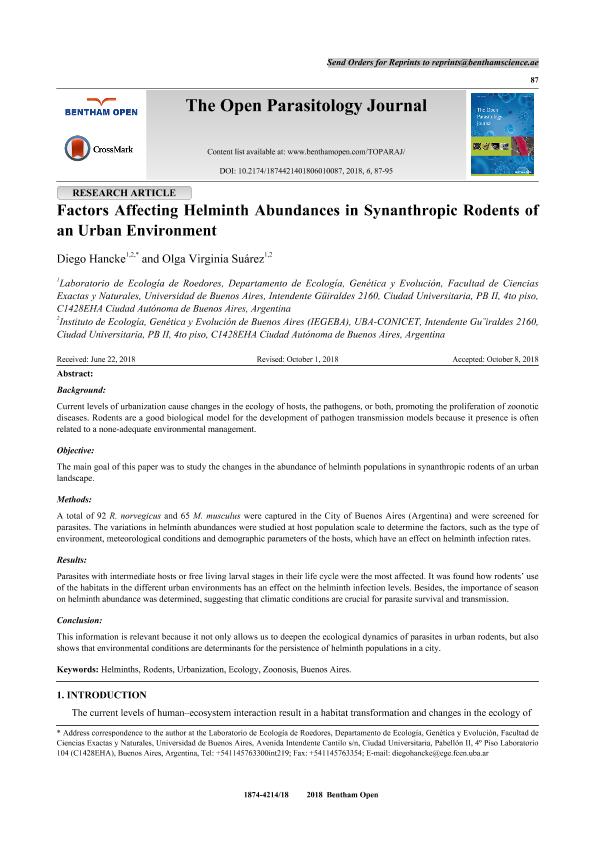Mostrar el registro sencillo del ítem
dc.contributor.author
Hancke, Diego

dc.contributor.author
Suarez, Olga Virginia

dc.date.available
2020-01-31T19:35:18Z
dc.date.issued
2018-10
dc.identifier.citation
Hancke, Diego; Suarez, Olga Virginia; Factors Affecting Helminth Abundances in Synanthropic Rodents of an Urban Environment; Bentham Open; The Open Parasitology Journal; 6; 1; 10-2018; 87-95
dc.identifier.issn
1874-4214
dc.identifier.uri
http://hdl.handle.net/11336/96412
dc.description.abstract
Background:Current levels of urbanization cause changes in the ecology of hosts, the pathogens, or both, promoting the proliferation of zoonotic diseases. Rodents are a good biological model for the development of pathogen transmission models because it presence is often related to a none-adequate environmental management.Objective:The main goal of this paper was to study the changes in the abundance of helminth populations in synanthropic rodents of an urban landscape.Methods:A total of 92 R. norvegicus and 65 M. musculus were captured in the City of Buenos Aires (Argentina) and were screened for parasites. The variations in helminth abundances were studied at host population scale to determine the factors, such as the type of environment, meteorological conditions and demographic parameters of the hosts, which have an effect on helminth infection rates.Results:Parasites with intermediate hosts or free living larval stages in their life cycle were the most affected. It was found how rodents? use of the habitats in the different urban environments has an effect on the helminth infection levels. Besides, the importance of season on helminth abundance was determined, suggesting that climatic conditions are crucial for parasite survival and transmission.Conclusion:This information is relevant because it not only allows us to deepen the ecological dynamics of parasites in urban rodents, but also shows that environmental conditions are determinants for the persistence of helminth populations in a city.
dc.format
application/pdf
dc.language.iso
eng
dc.publisher
Bentham Open
dc.rights
info:eu-repo/semantics/openAccess
dc.rights.uri
https://creativecommons.org/licenses/by-nc-sa/2.5/ar/
dc.subject
Helminths
dc.subject
Rodents
dc.subject
Urbanization
dc.subject
Ecology
dc.subject
Zoonosis
dc.subject
Buenos Aires
dc.subject.classification
Ecología

dc.subject.classification
Ciencias Biológicas

dc.subject.classification
CIENCIAS NATURALES Y EXACTAS

dc.subject.classification
Parasitología

dc.subject.classification
Ciencias de la Salud

dc.subject.classification
CIENCIAS MÉDICAS Y DE LA SALUD

dc.title
Factors Affecting Helminth Abundances in Synanthropic Rodents of an Urban Environment
dc.type
info:eu-repo/semantics/article
dc.type
info:ar-repo/semantics/artículo
dc.type
info:eu-repo/semantics/publishedVersion
dc.date.updated
2019-10-09T20:42:40Z
dc.journal.volume
6
dc.journal.number
1
dc.journal.pagination
87-95
dc.journal.pais
Emiratos Árabes Unidos

dc.journal.ciudad
Sharjah
dc.description.fil
Fil: Hancke, Diego. Consejo Nacional de Investigaciones Científicas y Técnicas. Oficina de Coordinación Administrativa Ciudad Universitaria. Instituto de Ecología, Genética y Evolución de Buenos Aires. Universidad de Buenos Aires. Facultad de Ciencias Exactas y Naturales. Instituto de Ecología, Genética y Evolución de Buenos Aires; Argentina
dc.description.fil
Fil: Suarez, Olga Virginia. Consejo Nacional de Investigaciones Científicas y Técnicas. Oficina de Coordinación Administrativa Ciudad Universitaria. Instituto de Ecología, Genética y Evolución de Buenos Aires. Universidad de Buenos Aires. Facultad de Ciencias Exactas y Naturales. Instituto de Ecología, Genética y Evolución de Buenos Aires; Argentina
dc.journal.title
The Open Parasitology Journal
dc.relation.alternativeid
info:eu-repo/semantics/altIdentifier/url/http://benthamopen.com/FULLTEXT/TOPARAJ-6-87
dc.relation.alternativeid
info:eu-repo/semantics/altIdentifier/doi/http://dx.doi.org/10.2174/1874421401806010087
Archivos asociados
